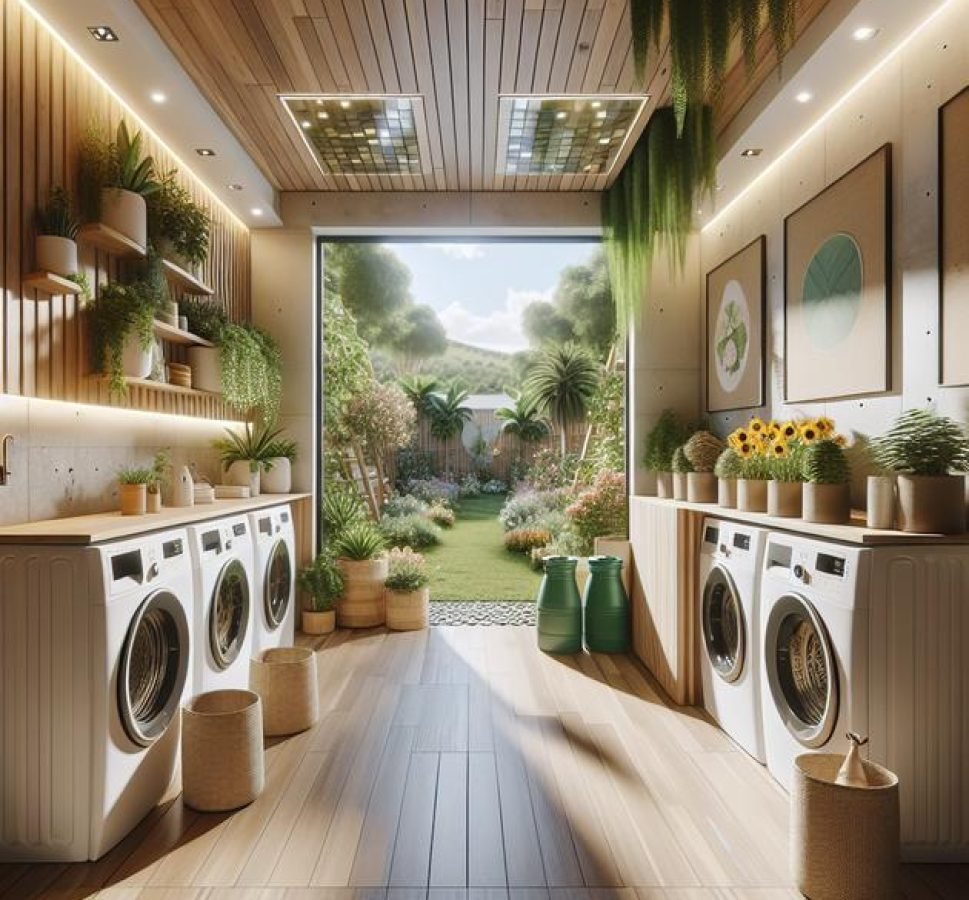An eco-friendly laundry room optimizes energy and water efficiency with smart appliances, biodegradable detergents, and sustainable materials such as bamboo, solar power integration, and innovative designs like waterless washing, significantly reducing environmental impact and promoting sustainable living in both residential and community settings.
Transforming your laundry space into an eco friendly laundry room is more than just a trend. It’s a step towards sustainable living. Imagine saving money on bills while contributing positively to the environment. Curious how? Let’s dive into some exciting ideas you’ll love!
why choose an eco friendly laundry room?
Opting for an eco friendly laundry room isn’t just about reducing your carbon footprint; it’s about creating a healthier home. By incorporating energy-efficient appliances and sustainable materials, you are investing in long-term savings and a more comfortable living environment.
One compelling reason to choose a green laundry room is the energy savings. Modern appliances are designed to consume less electricity and water, dramatically lowering utility bills. Additionally, eco-conscious choices such as LED lighting and natural ventilation further cut down energy use.
Another motivation for going green is the health benefits. Traditional laundry rooms often harbor harsh chemicals, whereas eco-friendly setups prioritize non-toxic cleaning agents, safeguarding your household from harmful substances.
Moreover, by embracing sustainability, you contribute positively to the planet by minimizing waste and resource consumption, making a conscious effort to live responsibly. Isn’t it time you considered an eco-friendly transformation?
key elements of a sustainable laundry room
Creating a sustainable laundry room involves selecting the right elements that minimize environmental impact while maximizing efficiency. Start by choosing appliances that are energy-efficient and carry the Energy Star label. These machines use less water and electricity, reducing your bills.
Consider incorporating sustainable materials into the design. Recycled and reclaimed materials, such as countertops made from recycled glass or tiles from reclaimed wood, not only look stylish but also reduce the need for new resources.
Use non-toxic cleaning products to maintain a healthy indoor environment. Many conventional detergents include chemicals that can harm both your family and the planet. Instead, seek out eco-friendly options that use plant-based ingredients.
Good ventilation is another essential element. Proper airflow prevents mold and mildew, enhancing the life of your laundry machines and maintaining air quality.
energy-efficient appliances for your laundry
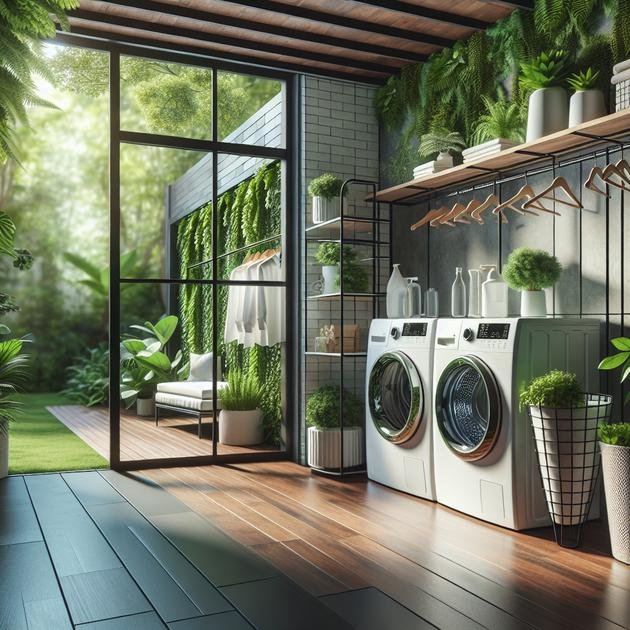
Choosing energy-efficient appliances for your laundry room is a smart move for both the environment and your wallet. Opt for washing machines and dryers that carry the Energy Star label. These appliances are designed to use up to 50% less energy and water compared to conventional models, significantly cutting utility costs over time.
When shopping for a washing machine, consider selecting a front-loading model. Front loaders typically consume less water and use less detergent, which benefits both the planet and your pocket. For dryers, look for models with moisture sensors that automatically stop the machine once clothes are dry, preventing unnecessary energy use.
Don’t overlook the importance of maintenance to ensure maximum efficiency. Regularly clean the lint filter in your dryer and check for blockages in the vents to maintain optimal airflow, reducing energy consumption and potential fire hazards.
water-saving techniques for washing clothes
Adopting water-saving techniques for washing clothes is key to making your laundry routine more sustainable. Start by using a high-efficiency washing machine, which consumes far less water than older models. These machines are designed to deliver excellent cleaning while conserving precious resources.
Another effective method is selecting the right water level setting. Always match the water level to the load size to prevent wastage. Many modern washing machines offer automatic sensors that adjust the water level according to the load, providing an efficient wash without excess.
Opt for short cycle washes whenever possible. Most laundry loads don’t require extended cycles, and sticking to shorter washes saves both water and energy. Additionally, only wash full loads; doing so maximizes efficiency and minimizes unnecessary water use.
For those committed to saving water, consider reusing greywater from your washing machine for non-potable purposes like toilet flushing or garden irrigation, provided local regulations allow. This step further reduces the environmental impact of your laundry activities.
eco-friendly detergents and alternatives
Switching to eco-friendly detergents can make a big difference in reducing the environmental impact of your laundry. These detergents are made from biodegradable ingredients that break down easily and don’t harm waterways or wildlife.
Many of these products are free from harsh chemicals like phosphates and synthetic fragrances, which means they’re gentler on your skin, too. Look for labels that highlight plant-based ingredients and eco certifications to ensure the products align with your sustainable goals.
In addition to store-bought options, consider using natural alternatives. Baking soda and vinegar, for instance, are excellent for softening clothes and removing odors without harming the environment. Soap nuts, which are actually berries, release a natural soap and can be used just like regular detergent for an effective, sustainable clean.
Whichever eco-friendly option you choose, ensure it’s suited to your washing machine to prevent any damage and ensure the best results.
repurposing and reusing in laundry setups
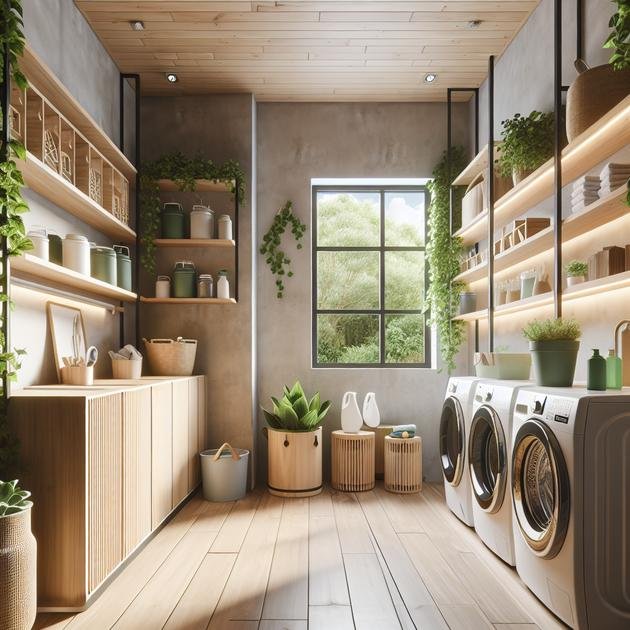
Incorporating repurposing and reusing strategies into your laundry setup is a fantastic way to enhance sustainability and creativity. Start by finding new uses for old containers. Reuse glass jars or metal tins for storing detergents and clothespins, keeping them accessible and adding a touch of charm to your space.
Look for second-hand furniture pieces that can be refurbished for your laundry room. An old wooden ladder can serve as a drying rack, saving energy while adding an interesting design element. Consider repainting or refinishing thrifted shelves for added storage without the need to purchase new items.
Transform vintage textiles into functional elements. Old curtains can be cut and sewn into laundry bags, while leftover fabric scraps can be crafted into reusable dryer sheets, reducing waste and giving your laundry room a personal, homemade touch.
By focusing on repurposing and reusing, you not only reduce waste but also create a unique space that’s both functional and aesthetically pleasing.
how to reduce plastic waste
Reducing plastic waste in your laundry routine can be simple and impactful. Start by replacing single-use plastic detergent bottles with refillable containers or packaging-free options. Many eco-friendly brands offer detergents in bulk, allowing you to refill your containers and cut down on waste.
Invest in reusable laundry bags instead of single-use plastic bags. These bags can be used to separate colors and delicates during washing, preventing damage while being eco-friendly. Similarly, swap out plastic hangers for sustainable alternatives made from wood or bamboo, which are both durable and environmentally friendly.
Avoid plastic-based fabric softeners by choosing natural alternatives like wool dryer balls. These not only reduce drying time but also soften clothes without the need for chemical-laden products. Additionally, adding a few drops of essential oils can give your laundry a pleasant scent without harmful additives.
Incorporate these simple changes to make a significant difference in reducing plastic waste in your laundry practices.
lighting choices to cut energy usage
Making the right lighting choices in your laundry room can significantly reduce energy consumption. Using LED bulbs is one of the simplest and most effective ways to cut down on energy usage. These bulbs use up to 75% less energy than traditional incandescent bulbs and last much longer.
Consider installing motion sensor lights that turn on only when someone is in the room. This ensures that lights are not left on unnecessarily, saving electricity. Additionally, prioritize natural lighting wherever possible. Leveraging windows or skylights can illuminate the space during daytime hours without using any energy at all.
If you’re renovating or designing a new laundry room, opt for light fixtures that enhance natural light and evenly disperse brightness throughout the room. Choose fixtures with reflective surfaces that maximize light distribution for a brighter space without additional bulbs.
Incorporating these lighting strategies will not only lower your energy bills but also contribute to a more sustainable living environment.
the role of indoor plants in a laundry room
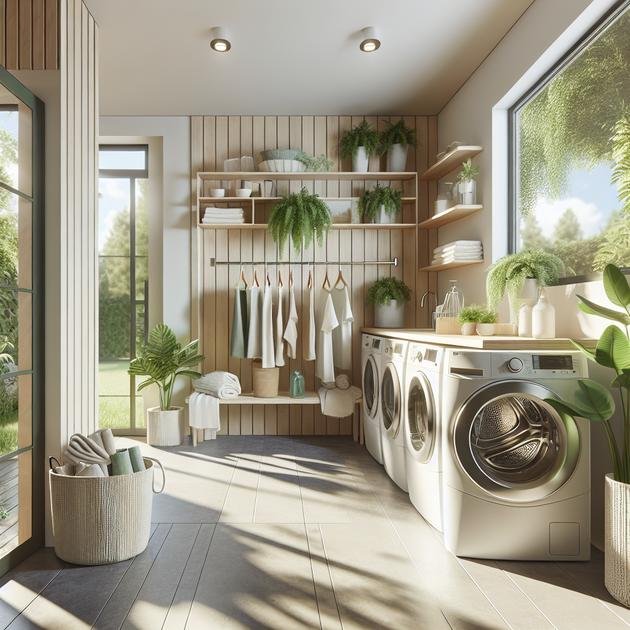
Incorporating indoor plants into your laundry room offers more than just visual appeal; they actively contribute to a healthier environment. Plants like peace lilies and spider plants can improve air quality by absorbing toxins and increasing humidity, creating a fresher atmosphere.
Smaller plants like succulents or snake plants can fit perfectly on shelves or countertops. They have low light and water needs, making them ideal for laundry rooms where natural light might be limited. Additionally, plants can help reduce stress and enhance mood, turning your laundry chores into a more pleasant experience.
Using hanging planters is a great way to maximize space without cluttering surfaces. These planters can add a stylish touch and bring greenery to eye level, enhancing the room’s aesthetic. Selecting plants that thrive in humid conditions will ensure they flourish in the environment created by running water and drying machines.
By incorporating the right plants, you not only enhance the aesthetic appeal but also introduce natural elements that improve air quality and bring tranquility to your laundry space.
DIY laundry room projects using recycled materials
Transforming your laundry space with DIY projects using recycled materials can be both eco-friendly and cost-effective. Start by repurposing old pallets into sturdy shelving units. Sand them down and paint in your preferred color for a chic, custom storage solution. Pallets are versatile and can easily be adapted to fit any space.
Look into using reclaimed wood for countertops or folding tables. This adds a rustic charm and ensures you’re giving new life to materials that might otherwise be discarded. Reclaimed wood is not only stylish but durable and environmentally conscious.
Convert vintage items like ladders into functional drying racks. Secure them horizontally on the wall, or suspend them from the ceiling to hang clothes. This creative solution adds character to the room without the need for buying new furniture.
Glass jars or tin cans can be upcycled into storage for clothespins and detergents. Paint and label these containers to keep your space organized while reducing waste. These small touches can turn a basic utility space into a personalized, sustainable haven.
finding the right storage solutions
Maximizing space in your laundry room is all about finding the right storage solutions. Start by utilizing vertical space. Install shelves above the washer and dryer to store detergents, fabric softeners, and other necessities. Using stackable bins can help keep these shelves organized and clutter-free.
Consider multi-purpose furniture such as a bench with built-in storage or a folding table that doubles as a storage unit. These items can keep your laundry room tidy while providing extra functionality. Storage carts with wheels are also ideal, allowing you to move cleaning supplies where needed easily.
For smaller items like clothespins and delicates bags, use clear jars or baskets. This not only keeps them visible and easy to grab but also adds a touch of elegance to the space. Hooks on the walls or inside cabinet doors can be perfect for hanging items like ironing boards or brooms.
By choosing smart storage options, you make your laundry tasks more efficient while maintaining a clean and organized environment.
the importance of proper ventilation
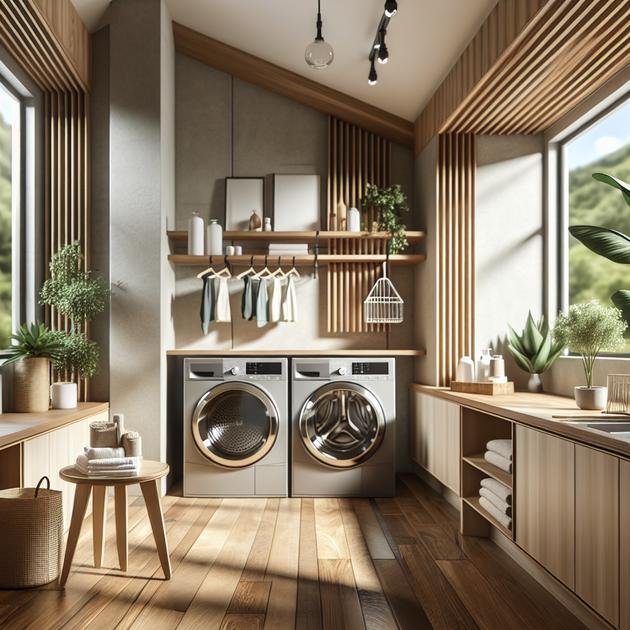
Ensuring proper ventilation in your laundry room is crucial for maintaining a healthy and efficient space. Good airflow helps to reduce moisture, preventing mold and mildew from developing. This is particularly important in enclosed areas where activities like washing and drying can increase humidity levels.
If your laundry room isn’t already equipped with a window, consider installing an exhaust fan to help remove excess moisture and odors. These fans are designed to quickly vent humid air outside, keeping the space dry and comfortable.
For those who have windows, make a habit of opening them periodically during and after using appliances. This simple action can significantly improve air circulation and air quality. Additionally, using a dehumidifier can be an effective way to maintain optimal humidity levels, especially in basements or areas prone to dampness.
Incorporating these ventilation strategies not only protects your laundry room and appliances from damage but also enhances the overall air quality, ensuring a fresh atmosphere.
cost-effective eco improvements
Making cost-effective eco improvements to your laundry room can significantly enhance sustainability without breaking the bank. Start by switching to LED lights. They use much less energy and last longer than traditional bulbs, resulting in lower electricity bills and reduced waste.
Install a low-flow water fixture on your laundry sink to conserve water. These are affordable and easy to install, yet they make a significant impact on reducing water usage. Pair these with a high-efficiency washing machine to further save on water and power.
Consider integrating a drying rack or line instead of relying solely on a dryer. Air drying your clothes can cut energy costs and extend the life of your garments. You can opt for retractable lines or wall-mounted racks that can be stored away when not in use.
Using reusable laundry aids like wool dryer balls instead of disposable dryer sheets is another simple swap. These balls help reduce drying time and soften clothes naturally. By implementing these changes, you create a greener laundry space while also keeping expenses low.
case studies of green laundry rooms
Exploring case studies of green laundry rooms provides practical insights into making eco-friendly improvements. Consider the case of a suburban home where the owners installed solar panels to power their laundry appliances. This switch drastically cut their energy bills and reliance on non-renewable resources.
Another inspiring example is a city apartment that transformed a small laundry nook with sustainable materials. They used bamboo shelving and recycled glass tiles to create a functional and stylish space that emphasizes eco-conscious design. The use of an energy-efficient washer and dryer complemented their efforts, further reducing their environmental footprint.
In a milestone project, a community laundromat embraced green innovations by implementing a rainwater harvesting system to supply water for washing machines. This initiative not only lowered water consumption but also educated the local community on sustainable practices.
These case studies highlight the versatility and benefits of adopting green practices in varied contexts, proving that sustainable improvements are accessible and effective in all types of laundry spaces.
home automation and smart tech integration
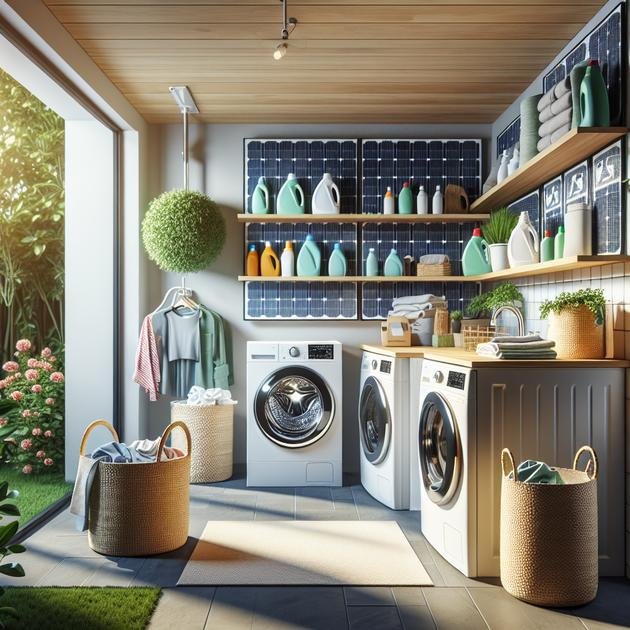
Integrating home automation and smart tech into your laundry room can drastically enhance efficiency and convenience. Consider using smart washers and dryers that connect to your smartphone. These appliances allow you to monitor cycles, receive alerts, and start or stop loads remotely, ensuring you manage laundry loads seamlessly.
Incorporate smart plugs for added control over your energy use. These devices can be programmed to turn off appliances during peak energy hours, helping reduce electricity bills. Furthermore, smart plugs often provide usage data, giving insights into your energy consumption patterns.
Installing sensors for water leaks is a valuable precaution. These sensors can immediately alert you to any leaks, preventing water damage and conserving resources. Pair these with smart lighting systems that adjust based on occupancy, ensuring lights are used only when needed.
By harnessing smart technology, you not only enhance your control over the laundry process but also contribute to a more sustainable and cost-effective household.
common mistakes to avoid
When designing an eco-friendly laundry room, there are common mistakes to avoid to ensure optimal functionality and sustainability. One frequent error is overlooking ventilation. Proper airflow is essential to prevent mold and mildew, so always include windows or exhaust fans to keep the air fresh and dry.
Another mistake is underestimating energy use. Not all appliances are created equal—choose models that are energy-efficient, carry the Energy Star label, and fit your actual needs to avoid excessive energy consumption. Similarly, neglecting to install water-saving fixtures can lead to higher bills and wasted resources.
Many forget the impact of using chemical-heavy detergents. These not only harm the environment but can also damage clothes and irritate sensitive skin. Switch to eco-friendly alternatives to keep your laundry safe and sustainable.
Finally, ignoring storage solutions can create clutter and reduce efficiency. Make sure to incorporate adequate shelving and organizational tools to keep the space tidy and functional.
the future of sustainable laundry rooms
As we look to the future of sustainable laundry rooms, technology and innovation are paving the way for greener solutions. One exciting development is the advent of smart appliances that optimize water and energy usage, learning from user habits to minimize waste. These devices will increasingly use AI to adjust wash cycles and temperatures based on garment needs.
Emerging waterless washing technology is set to transform the industry. This innovation uses special polymers or pressurized carbon dioxide to clean clothes, drastically reducing water consumption and chemical use. Such advancements promise to make laundry rooms much more environment-friendly.
As sustainability becomes a priority, biodegradable detergents and zero-waste packaging will become the norm. Products made from plant-based ingredients that break down naturally will replace their conventional counterparts, reducing pollution and promoting health.
Furthermore, renewable energy sources such as solar power integrated into laundry operations will lower carbon footprints. Future designs will also prioritize space efficiency, incorporating modular storage and multi-functional spaces to accommodate small living spaces.
Embracing the Green Revolution in Laundry
The evolution of laundry rooms into eco-friendly havens is both exciting and essential. By integrating energy-efficient appliances and innovative technologies, you can significantly reduce your environmental impact. From smart tech and sustainable materials to the future of waterless washing, each step forward enhances both efficiency and sustainability.
Emphasizing biodegradable products and maximizing natural resources like solar power, these advancements not only protect the planet but also transform everyday routines into conscious acts. A sustainable laundry room is more than a choice; it is a commitment to a healthier, greener future for all.
As you explore these possibilities, remember that every small change contributes to a larger impact. Why not start today and join the green revolution?


